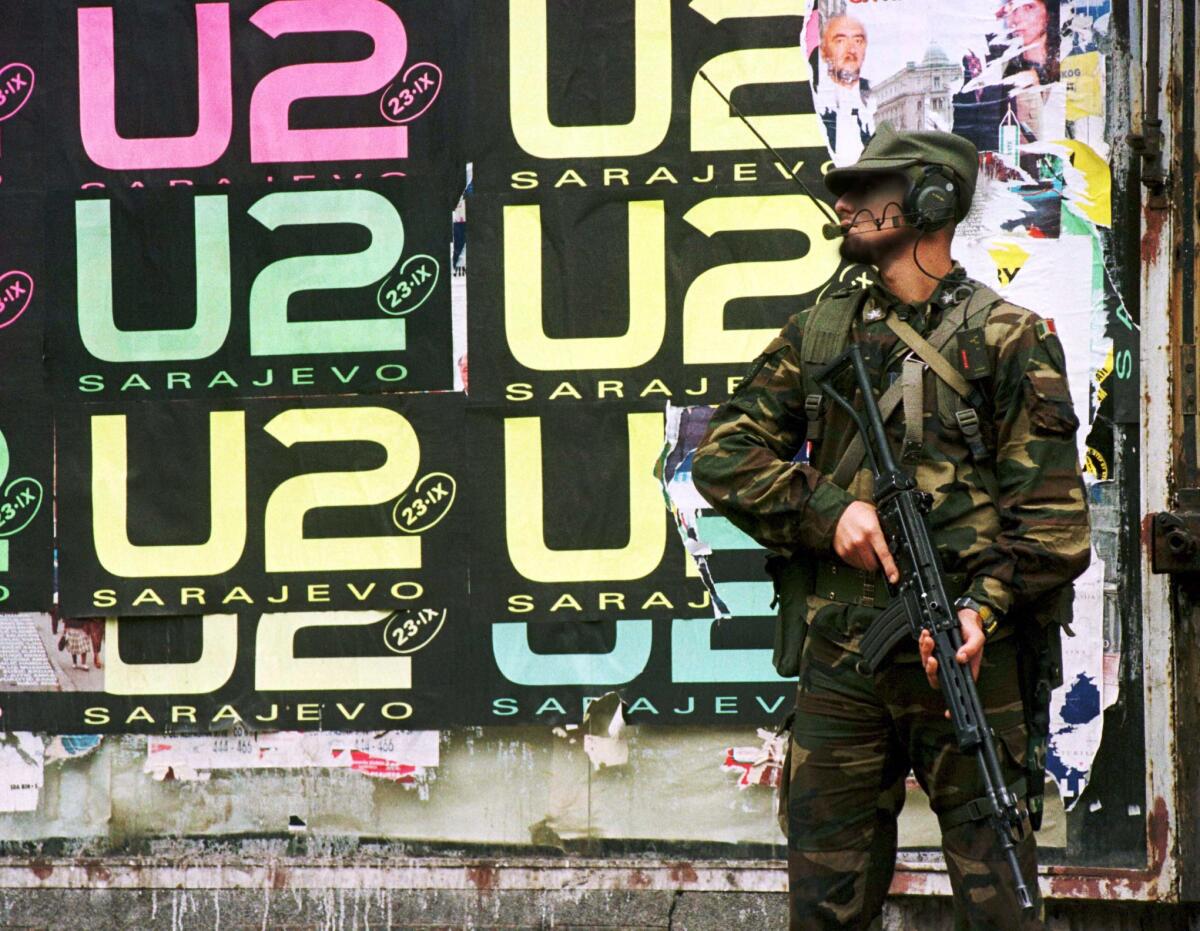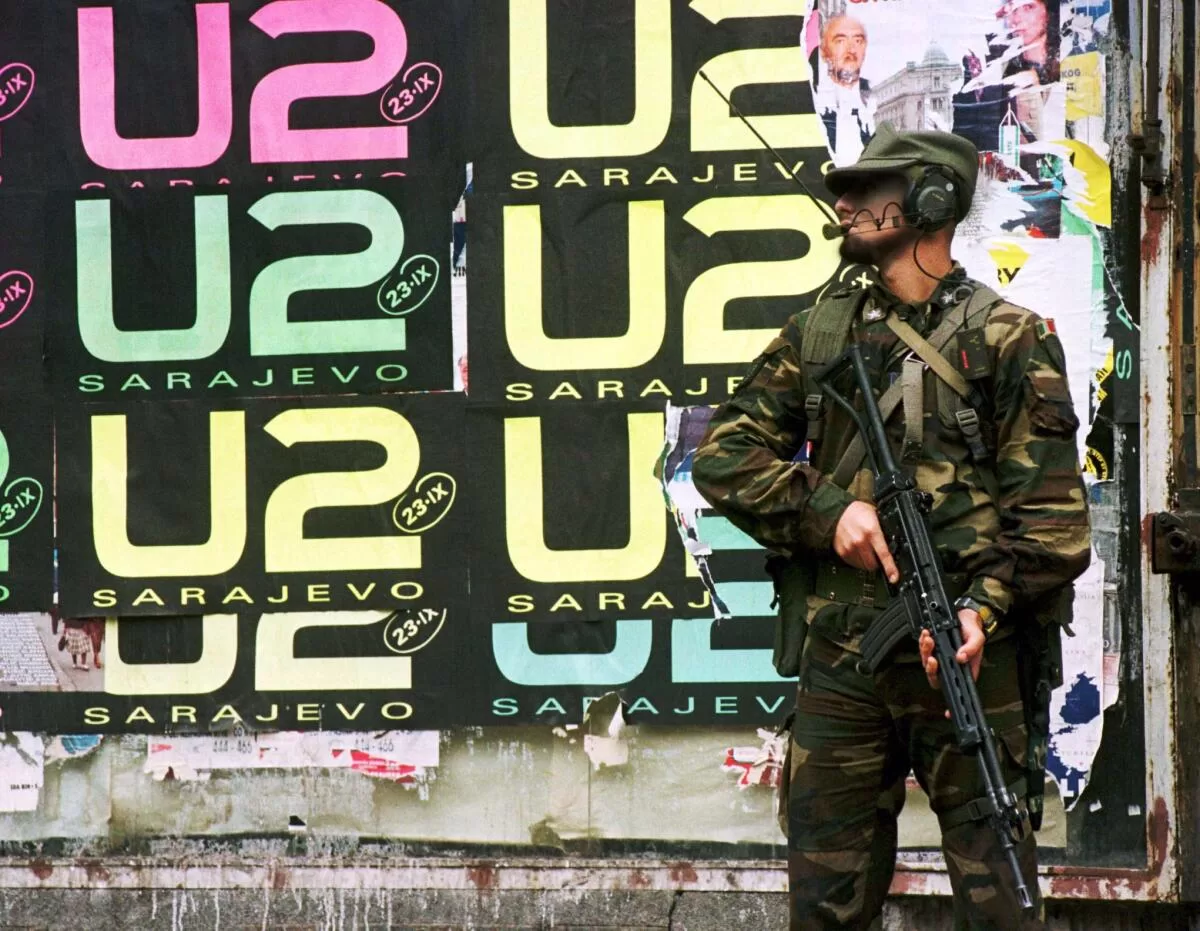
A besieged Sarajevo turns to music in 'Kiss the Future' and one band hears the call
Robert AbeleFeb. 23, 2024
Across During the years of relentless attacks on Sarajevo in the early 1990s, residents tried to turn off the sounds of the siege all around them by turning on music
:
as a release,
of course,
but also as a bid to feel normal amid Serbian bombs and sniper fire. What happened when this underground scenes
rock-tinged strains of
defiance reached U2 frontman Bonos ears is
at
the
beating
heart of director Nenad Cicin-Sains documentary Kiss the Future.
T
Just as the Oscar-nominated Ukraine dispatch 20 Days at Mariupol galvanizes
us
with its portrait of life under an aggressors evil, and the hit Netflix doc The Greatest Night in Pop reassures
us viewers
that good is possible when artists come together for a cause,
. T
the
war-meets-music
story that Kiss the Future tells culminating in U2s 1997 concert in Sarajevo, two years after the Dayton
p
Peace
accords Agreement
offers an admirably potent blend of darkness and light. Specifically, the light that can emerge from darkness.
In
its the film’s
archival video, home footage
,
and testimonials, its a harrowing reminder of the Bosnian Wars impact on
besieged
Sarajevans, told by the people who lived through it (and its most famous correspondent, CNNs Christiane Amanpour, as well as former
US
President Bill Clinton). But it also shows what renewal looks like when one of the biggest bands in the world represented here by interviews with Bono,
T
the Edge
,
and Adam Clayton amplifies your plight and makes good on a promise to celebrate your survival. Only a few years prior to that celebrated show at Sarajevos Koevo stadium, the onetime Olympic venue had been a wartime grave site.
First, Cicin-Sain offers a helpful primer in how Yugoslavias breakup set the stage for a territorial war waged by Bosnian Serbs,
directed led
by Slobodan Milosevic
,
and designed to shatter the multiethnic fabric of Sarajevo. As atrocities mounted, the city crumbled
,
and world leaders did nothing
, c
. But culture-starved Sarajevans created a thriving
,
generator-powered basement scene of art,
dance,
rock (one drummer kept showing up to play after losing a hand),
danceing,
theater
(a punk Hair proved popular),
and spotty TV broadcasts.
In 1993, Bill Carter, a young transplanted American aid worker (and a regular onscreen commentator), schemed to get Sarajevos troubles noticed by angling for an interview with Bono when U2s media-circus-themed Zoo TV tour stopped in nearby Italy. The appeal to prestige rocks premier empath worked:
.
The footage from that consequential 13-minute meet-up is fascinating.
; w W
e see Bono transform from a no-eye-contact
-please
megastar
s hesitancy
to an activist son of Ireland in full engagement
with the power to help
.
Soon, the band was regularly interrupting their European concerts for real-time satellite linkups to Carter in undisclosed locations.
with everyday Sarajevans, even if, the members admit now, U2 now admits
that these well-intentioned bids to spread
needed
awareness smacked of reality TV:
pain and anguish as entertainment,
Bono describes it
here
as pain and anguish as entertainment in a welcome moment of candor
about the pitfalls of mixing principles and performance
.
In its brisk pace, well-deployed song choices
,
and storytelling energy, Kiss the Future is
fairly
skillful at avoiding seeming like an ode to U2, even though the band’s involvement
fillsis
over half the movie.
, and t T
he 1997 concert is certainly presented as the moment
when
Bosnians felt theyd re-entered the wider world. It does seem a missed opportunity, however, not to give us more about the local bands
that were
chosen to open for U2, or richer sketches of the Bosnian participants for whom we know art was a regular lifeline.
Much is made, though, of that In the
- most ironic of setbacks for a consciousness-raising pop star
-
, Bono’s
shot vocal cords
that left himBono
unable to sing through much of the bands set list. It may be
a the
reason
why
footage from that eventful night in Sarajevo hasnt been widely seen outside U2s inner circle.
before Kiss the Future.
But
it’s a
lso why this heartfelt documentary is the right
platformvenue
for it,
since we learn given
who made up for all those missing verses: a battle-scarred but emotional audience of over 40,000
people
who knew
the every
word
s,
and could fill
the absence with aat gap with a free, clear and
collective voice.
</article>
